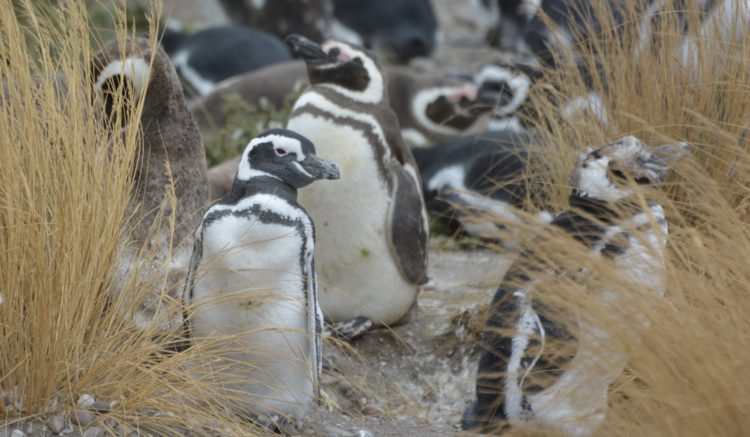From Puerto Madryn, we drove 318kms south down the coast of Western Patagonia along the RN3 highway in our Dragoman truck. Our destination was the small settlement of Camarones for an afternoon visit to the large penguin colony at Cabo dos Bahías and camped overnight at the Camarones Municipal Campsite.
Camarones, a small coastal town on the shores of the Atlantic, offers a glimpse into the untamed beauty of Eastern Patagonia. Located a day’s drive south of Puerto Madryn, this region is defined by its semi-arid landscape, rugged coastline, and rich wildlife. As part of Western Patagonia, it contrasts sharply with the fertile pampas surrounding Buenos Aires, providing visitors with a different view of Argentina’s vast geography. This leg of the journey, along the RN3 highway, reveals the stark beauty of a land where human settlements are scarce and nature reigns supreme.





Magellanic penguins at Cabo Dos Bahías, Argentina
Cabo Dos Bahías – Penguin Colony
A short drive from Camarones, Cabo Dos Bahías is home to one of the largest Magellanic penguin (Spheniscus magellanicus) colonies in the region. This protected area offers a more secluded and intimate experience with the penguins compared to the larger colonies on the Valdés Peninsula. The penguins here nest in burrows dug into the sandy earth, sometimes just metres from the cliffs that drop dramatically into the sea. With the Atlantic crashing against the rocky shore, the setting is both wild and serene.
During the breeding season, the colony is teeming with activity as adult penguins guard their nests, mate, or feed their chicks. The sight of thousands of penguins standing in the sun, calling to their partners or preening themselves, is an unforgettable experience. Visitors can also spot other species such as guanacos (Lama guanicoe), rheas (Rhea americana), and various seabirds, making Cabo Dos Bahías a must-visit for nature lovers.

Orcas, Camarones, Patagonia, Argentina
Orcas and Marine Life
As with Puerto Madryn, the waters around Camarones are frequented by orcas (Orcinus orca), especially during the summer months. Known for their unique hunting behaviour, orcas in this region have developed the ability to beach themselves temporarily to catch prey, including young sea lions and penguins. While we did not witness this behaviour firsthand, we did spot a pod of five orcas patrolling the coastline, a reminder of the raw and untamed nature of this remote part of Patagonia.
Flora and Fauna of Eastern Patagonia
Much of Eastern Patagonia is covered by low-lying shrubs and hardy grasses, adapted to the arid climate and strong winds that sweep across the steppe. Despite the harsh conditions, this region supports a surprising variety of wildlife. Guanacos, related to llamas, roam the steppe in small herds, while Darwin’s rheas, flightless birds resembling ostriches, dart through the sparse vegetation. Along the coastline, sea lions and elephant seals bask on rocky outcrops, while seabirds wheel overhead in search of food.
One of the more curious creatures of this region is the burrowing owl (Athene cunicularia), which, as its name suggests, lives in underground burrows. These small, long-legged owls are often seen perched atop mounds of earth or peering out from their burrows, adding a whimsical charm to the rugged landscape. They share their habitat with penguins, often living in close proximity to the penguin colonies at Cabo Dos Bahías.

Sunset, Camarones, Patagonia, Argentina
Landscape and Climate: Patagonia vs. Pampas
The landscape of Eastern Patagonia is dominated by vast stretches of semi-arid scrubland, characterised by sparse, drought-resistant vegetation and a dry, windy climate. The endless skies and dramatic sunsets paint the land in soft hues of yellow and green, a stark contrast to the lush, fertile pampas near Buenos Aires. In the pampas, Argentina’s breadbasket, neat ranches with cattle and expansive fields of grain create a picturesque scene of agrarian abundance. The soil there is incredibly fertile, allowing for large-scale agriculture, which is a critical part of Argentina’s economy. The settlements in the pampas hum with the industrial activity of processing plants, silos, and transportation hubs for agricultural exports.
In contrast, Eastern Patagonia’s harsh environment supports only small towns and isolated industrial outposts, often aligned with Argentina’s efforts to develop this remote region.
From Camarones we drove a further 435kms South along the RN3 eventually stopping off for our first experience of a genuine bush camp on the beach a few kilometres north of the small coastal town of Puerto San Julian.



Bush Camp near Puerto San Julian and Bush Camp near Puerto San Julian, Argentina
On our way we stopped off in Comodoro Rivadavia to collect supplies, which is one of the largest in Patagonia and is a stark contrast to the natural beauty of the surrounding area. Established in 1901 as a small port, Comodoro Rivadavia became a crucial hub for Argentina’s oil industry after petroleum was discovered nearby in 1907. Today, the region is dotted with “nodding donkeys,” oil rigs extracting petroleum from the vast reserves beneath the arid Patagonian steppe. The city has grown into an industrial centre, its economy closely tied to the energy sector. While Comodoro itself may not boast the tourist appeal of other Patagonian towns, its strategic importance as an oil producer plays a key role in Argentina’s broader economic landscape. The juxtaposition of the industrial skyline against the rugged cliffs and deep blue Atlantic waters adds another dimension to the diverse geography of Patagonia.
Despite the unassuming settlements, the coastline itself remains striking, and a perfect spot to break the long journey to major sites around El Calafate and El Chalten, with dramatic cliffs meeting the deep blue Atlantic Ocean, none more so than where we set up our bush camp on the beach, with the ocean on one side and dramatic cliffs on the other.
Dates 09/03/2018 to 11/03/2018 – Dragoman Days 6 & 7
